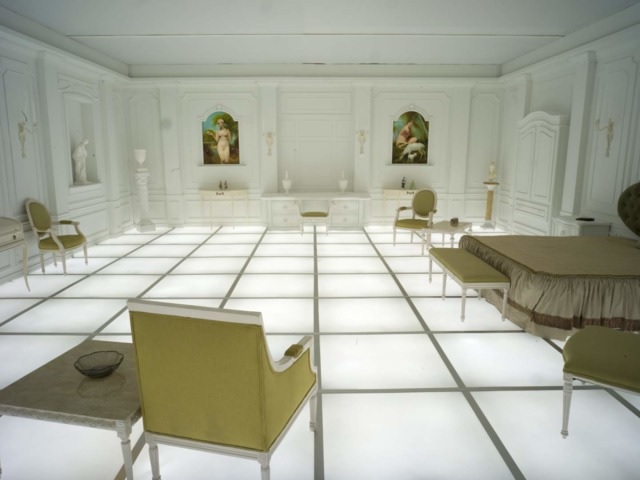In a White Room: "Barmecide Feast" Reviewed
Washington City Paper, April 5, 2018 Magazine Work

"The Barmecide Feast" by Simon Birch.
Let's count the many ways Stanley Kubrick's 2001: A Space Odyssey got the future wrong.
We're still a decade away from commercial shuttle service ferrying earthlings into orbit and still farther from giant rotating orbital space stations. Sentient computers? Not yet. We've built no moon colonies. Manned interplanetary travel won't happen until Elon Musk gets to it, and cryogenic hibernation is no more practical today than it was 50 years ago this week, when 2001 debuted at Cleveland Park's Uptown Theater.
But Kubrick did get one thing about the future dead right: The design and décor of the interstellar way-station at the end of the stargate corridor, where astronauts go to be reborn as star children. Kubrick's room now lives outside the world of film thanks to artist Simon Birch and architect Paul Kimber, who built a replica of it for a group show in Los Angeles. Currently on exhibit at the National Air and Space Museum, Birch titled his work "The Barmecide Feast" after a story from One Thousand and One Nights about a beggar imagining a feast and then experiencing one.
The rococo Louis XIV room faithfully recreates the Kubrick movie set without exactly cloning it--don't go looking for the bathroom from the film, as it's not there. As in 2001, the walls and cabinetry are painted white and off-white and the furnishings are done in several shades of puke green. Figurines, sculptures, and paintings (originals by artist Dominique Fung) accent the walls and tabletops. It's kind of perfect without being pristine. The occasional paint smudge and crack make the room feel like an interstellar Airbnb that's seen a fair bit of use.
But it's the installation's floor that gives the room its visual power and mystery. Translucent and crisscrossed with black bands, echoing the brain-bending psychedelic light show of the movie's stargate ride, the floor glows as if lit from below by two dozen full moons. Martin Collins, the museum's space history curator, gets it right when he comments that the indirect light makes the room feel warm and cold at the same time, infusing the space with a soft, heavenly glow. It's as shadowless as a landscape draped by snowfall and illuminated by a weak sun burning through a thin fog. Original music composed by Gray Gunn for the installation probably adds to the effect, but the chattiness of the press tour kept interrupting.
According to Michael Benson's fine new book about the movie, Space Odyssey, the narrative function of the room was to serve as a kind of "human zoo"--built by unseen aliens--where astronaut David Bowman could recover from his wormhole trip and prepare for his transformation. Experienced in this museum setting, Kubrick's room will pack the frisson of a theme-park ride for devotees of the film. Those who haven't committed the film to memory can anticipate a Zen-like cooling of the senses.
Like the movie that inspired it, the room projects both wonder and serenity. How much of that impact flows from memories of the film, I can't say. Having seen 2001: A Space Odyssey during its first run a half-century ago and at least a dozen times in cinemas since then, my time inside the room felt like a brief visit to my favorite recurring dream. Enter "The Barmecide Feast" knowing that you'll want to trap the moment with a bunch of selfies. Exit it wishing that you, too, could transform into a star child.
